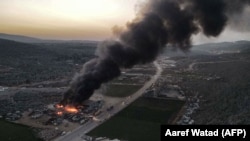On April 14, the Iranian state-owned news outlet Press TV published an article citing a Syrian Foreign Ministry statement that blamed the United States for the destruction in Syria’s civil war.
“Damascus says the U.S. is fully responsible for the adverse outcome of its criminal policies against Syria, calling on Washington to stop its intervention in the Arab country’s domestic affairs and compensate for the losses the nation has suffered as a result of the American military aggression and troop deployment,” the article stated.
It directly quoted the Syrian Ministry of Foreign Affairs and Expatriates as saying: “Developments and facts have unquestionably proven the involvement of the U.S. and its proxies across the region and worldwide in an unprecedented terrorist war against the Syrian Arab Republic.”
Those statements are misleading.
Much, if not most, of the destruction in Syria – in terms of casualties, displaced people, and damage to infrastructure and cities – was caused by the forces of President Bashar al-Assad’s regime.
The United Nations has called the Syrian civil war, now a decade old, “the world’s largest humanitarian crisis.” Estimates of the number of people killed in the conflict (military and civilian) range from 400,000 to 600,000.
Monitors from the Syrian Network for Human Rights, a U.K.-based independent monitoring group, said the regime had been responsible for 89 percent of an estimated 200,000 civilian deaths from 2011 to 2019. The same group estimated that nearly 150,000 civilians have been “disappeared” by the regime, their fates unknown.
By contrast, approximately 3,036 civilians, 1.4 percent of the total killed in the same 2011-2019 time period, were casualties of U.S.-led coalition forces, the Syrian rights network documented. These were mostly deaths in air strikes in support of the Kurdish-led Syrian Democratic Forces’ offensive against the Islamic State in the eastern part of the country. (The rights group attributed Assad's ally Russia with 2.8 percent of the fatalities.)
The Assad regime’s tactics are responsible for the high number of civilian deaths. Early on in the conflict, during 2011-2012, the Syrian Arab Army experienced a wave of defections. Rather than let his forces be ground down in house-to-house urban combat, Assad turned to his one advantage over the rebels – the Syrian Arab Air Force.
The regime used siege tactics against rebel-held cities, employing a combination of air strikes and artillery. The cities of Homs and Aleppo were subjected to protracted sieges and bombardment, and the destruction of their buildings and infrastructure is still evident today.
The regime’s air force quickly became known for indiscriminate bombing, often using highly-destructive improvised “barrel bombs” – large metal cylinders packed with high explosives and usually scraps of metal that become deadly shrapnel.
The regime’s air force has also used chemical weapons in more than 300 attacks documented by the Berlin-based Global Public Policy Institute. Recently, the Organization for the Prohibition of Chemical Weapons (OPCW) released a new report blaming the regime for another chemical attack in Saraqib in February 2018.
The destruction of Syria’s major cities has created a staggering refugee crisis. Approximately 6 million people have been displaced inside Syria, while 5.6 million others have fled abroad, many risking dangerous sea passage to escape to Europe.
In 2019, human rights monitors accused the Syrian government of targeting farmland in northern Syria with incendiary munitions, in what they said was an attempt to starve the remaining rebel-controlled enclaves in and around the city of Idlib. Nearly four million people live in Idlib under an uneasy ceasefire agreement brokered by Russia and Turkey last year. However, in late March, Russia launched several strikes against targets near the critical Bab al-Hawa border crossing between rebel-held Syrian territory and Turkey.
All of these factors have taken a serious toll on Syria’s economy, as well as the country’s ability to rebuild.
Although the Assad regime blames the United States for the war, that flies in the face of well-established historical facts. The conflict began in 2011, when Syrian security forces began using live ammunition against peaceful protesters. Assad’s military and militia forces waged war under slogans like “Assad or we burn the country.”





